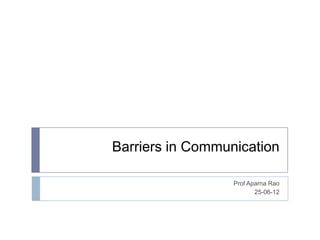
Barriers in organizational communication
- 1. Barriers in Communication Prof Aparna Rao 25-06-12
- 2. FEATURES OF COMMUNICATION Dynamic: Constantly changing Continuous: You cannot ‘not’ communicate Two-way/circular: Never one way Unrepeatable: Same message, same sender can have different meanings for different listeners Irreversible: Once said… Complex: Multiple cycles, multiple processes at one time
- 3. Communication Skills for Managers Barriers to Effective Communication Messages that are unclear, incomplete, difficult to understand Messages sent over the an inappropriate medium Messages with no provision for feedback Messages that are received but ignored Messages that are misunderstood Messages delivered through automated systems that lack the human element 15–3 © Copyright McGraw-Hill. All rights reserved.
- 4. 21st Century Workplace Challenges & Demands Present workplace Multi-cultural Multiple time zones Languages People Technology Expectations – Knowledge workers Communication
- 5. Cultural Differences Global Village – Internet, Skype, Technology, time zone barriers Not necessary, but useful to be multi- lingual Accent Neutralization Barriers built in from childhood – mindset – ‘not my fault’ / ‘am so strong’ Mindset evolving towards projection Multi-ethnic
- 6. Types of Barriers Physical Psycho-social Cultural Linguistic Semantic Body Language
- 7. Physical Barriers Physical Barriers Challenges of multi-tasking - Man, by nature, not wired for this Speed of thinking, talking, typing – 200 wpm, 80 wpm, 40 wpm -Deficit Word pickers – During a talk/conversation one word may trigger a feeling of ‘I know what’s coming’ Concentration time – Linkages – miss the talk, snap back with change of inflection/tone etc Medium Interference – in communication, eating, driving, talking on the cellphone while walking on the road/public travel, texting in class…
- 8. Cultural Differences The result of U.S. warning to Japan for unconditional surrender - an ambiguous ‘mokusatu’ – meaning ‘to kill with silence’ Tokyo radio used the word, saying the government would mokusato the declaration and fight on…The English translation became ‘reject’ and the President took it as a rebuff. The result? Egyptian pilots radioed (in English) their intention to land at an airbase on Cyprus, and the Greek traffic controllers reportedly responded with silence, indicating refusal The Egyptians’ interpretation of this silence – assent The outcome? Lives lost…
- 9. Cultural Differences Assuming Similarity -Danish Woman with baby in the US Assuming Difference – Urban/rural; Eastern/Western/South/North etc. Eye Contact – Critical – Differences in stare, gaze, lecherous look, business look … Gestures – Thumbs up, Victory sign – meanings Basic unwritten rule to follow – no assumptions, no judgments; ‘Believe nothing of what you hear and only half of what you see’
- 10. Linguistic Differences Language, Culture & Body Language – inter-twined E.g. English – You; Yes, yeah Indian languages – Aap, Tum, tu; words describing relationships – cousin, aunt, mausera bhai, chachera bhai, mausi, chachi, maami etc. Word bai – in Hindi and Marathi When disrespect is perceived, the message is lost in the emotional thought process over the disrespect
- 11. Semantic Differences French Lemonade – cannot be launched with the same name in English speaking countries Japanese brand of cold drink Argentinian curry powder - Poo German drink Portugal tuna – Atum bum Communication is about making meaning… make sure you communicate what you are meant to The intended outcome of the message should be clear to sender and receiver
- 12. Psycho-Social Barriers Status Horns/Halo Effect Allness & Closed Mind Resistance to Change Unclarified Assumption Different Perceptions
- 13. Organizational Barriers Communication Relationship Satisfaction Extent to which available information meets task- related and general information needs of employees in an organization Perceptions of Justice – Distributive, Procedural & interactional Justice Evaluated by 4 aspects of communication in an organization – with immediate superiors, peers, top management & overall communication within the organization
- 14. Justice – Multi dimensional Construct Distributional Justice – Fairness of the outcome of the process Procedural – Fairness perceived in the policies, procedures and criteria followed in the process Interactional – perceptions about the manner of treatment of people
- 15. Premises & Survey Findings There is a positive correlation between CRS and all facets of organizational communication CRS and top management would provide strong predictions for distributive and procedural justice CRS with immediate supervisor is a predictor for interactional justice Necessary to ensure that messages are routed through communication channels
- 16. BARRIERS TO COMMUNICATION •PERCEPTUAL BARRIERS •CONTENT BARRIERS Content Known/Unknown, Disinterest •PERSONAL BARRIERS Poor Listening/ Thinking of response
- 17. BARRIERS TO COMMUNICATION •ENVIRONMENTAL BARRIERS Light/Air/Noise/Ventilation/Interruption •LINGUISTIC BARRIERS Language/Semantics/Tone/Delivery Style •PSYCHOLOGICAL BARRIERS Frustrated/Anxiety/Anger/Status •PHYSIOLOGICAL BARRIERS Brain-Tongue Speed/ Unwell
- 19. Language Barriers 'Ici on parle Anglais'... 'Ici on se rit de votre francais.' ('We speak English here'... 'We laugh at your French here')
- 20. What Kind of Barriers Do You See Here?
- 21. Types of Barriers Interpersonal – Takes into account uniqueness of individuals due to age, perceptions, experiences, education, culture, pe rsonality – interpretation differs – e.g.??? Causes – Wrong assumptions, varied perceptions, wrong inferences, differing background, blocked categories Prevent or overcome – ‘You’ attitude, audience oriented choice of words, technical words to be explained, avoid oversimplification
- 22. Prevent or Overcome Organizational Barriers Keep receiver in mind Open communication environment Avoid too many transfer stations Avoid communication when emotionally disturbed Be aware of diversity in culture, language etc. Use appropriate non-verbal cues Select most suitable medium Analyse feedback
- 23. Additional Reading http://cte.uwaterloo.ca/teaching_resources/tips/effective_ communication_barriers_and_strategies.html - Strategies http://www.radford.edu/~kvharring/docs/HRMDocs/5com m.pdf - Communication across cultural barriers http://healthadmin.jbpub.com/Borkowski/chapter4.pdf - Workplace Communication http://www.diversity-matters.net/publications-gestures.pdf - Gestures http://www.languagetrainers.co.uk/blog/2007/09/24/top- 10-hand-gestures/ - Hand gestures to avoid www.vikalpa.com/pdf/articles/2010/page-vol-35-55-65.pdf
- 24. Thank You
